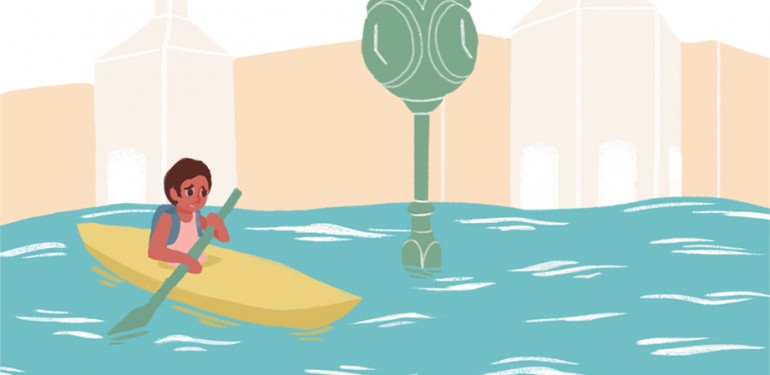A team of students is developing a program to monitor campus flooding by creating an alert system for the Mason community.
“We’re trying to develop what I’m calling the Mason Educational Watershed, which is to create Mason as a living laboratory for Water Resources Engineering,” said Celso Ferreira, a water resources engineering professor.
Last fall, Ferreira received a $45,000 grant from the Dominion Foundation for Higher Education in order to pursue this project. He has had the idea since his arrival at Mason two years ago, and data collection is just getting started. Ferreira has done research on water resources systems analysis, hurricane storm surge modeling and hydrology and has a doctorate in water resources from Texas A&M.
“We’re installing equipment all around campus to monitor flooding, but our equipment is very recent so we haven’t captured a flooding event yet,” Ferreira said.
This equipment includes little white sensors that the student team is currently placing in streams all over campus and a high-tech weather station that can send immediate results to a computer.
“Each little river here has a sensor that will tell us flood levels, and we have a weather station that’s catching rainfall in real time and will tell us when there’s an extreme event,” Ferreira said.
According to Ferreira, one long-term goal of the project is to create a website for students, faculty and staff that posts real time flood alerts to provide useful information .
According to Ferreira, creation of the website has not started yet.
“The reason we’re not there yet is this is also student-led,” Ferreira said. “Maybe I’m kind of somehow leading here, but the students are performing the task. Students have classes, they’re busy, so it takes so much longer than we want it, but that’s the direction we’re going.”
Ferreira said the website is important to the study because its effects could be applied to real-life situations.
“One thing I wanted to study is how the media can help prevent disasters or flooding disasters,” Ferreira said. “Mason is a small scale of the entire country, the world or whatever you want. When I say disaster it might be, ‘Okay I’m getting my feet wet coming out of Southside,’ but [in real life] it could be Hurricane Katrina and your house is under water.”
The technology that would enable the website is state-of-the-art, according to Ferreira, and thus enhances the learning experience of each student involved in the project.
“One of the things we wanted to do is have the most up-to-date technology that you can think of on the face of the earth here for the students to use,” Ferreira said. “Even if there were no flooding issue we would do it anyway because we’re an educational institution.”
According to Ferreira, the hands-on experience with technology is essential for preparing students to deal with future, real-life disasters.
“We want our students to do civil engineering, to learn how to use that, so that when they go work to prevent Katrinas and Sandys they know how deal with equipment and things and all of that,” Ferreira said.
This past summer, Ferreira and an undergraduate student began collecting data and observed flooded areas close to Southside. Ferreira said that despite these observations, there is not yet scientific proof of a flooding event on campus and more times needs to pass before the data can be usefully analyzed. He said the project is in its beginning stages and will continue to evolve.
“During the summer was our kind of first stretch and this will be going on now for years to come,” Ferreira said.
According to Ferreira, Mason is an ideal place to conduct this study because the entire campus acts as a watershed.
“We’re within a watershed that’s contained inside campus, and a watershed is an area [where] the water is contained within,” Ferreira said. “If it rains inside a watershed, all the water that falls inside a watershed will drain to a different point…so any rain that falls in here, exactly where we are, will drain through Mason and get out at Braddock Road.”
Ferreira is also enthusiastic about working on the project at Mason because certain amenities are advantageous to research.
“It’s an exciting place to be,” Ferreira said. “We can connect this technology and see how [it is] effectively solving the problem that we face in our everyday life outside [Mason] where we don’t have these facilities, where we don’t have too much of a green infrastructure and we don’t have a sustainability vision which Mason kind of has, so I think it’s cool.”



